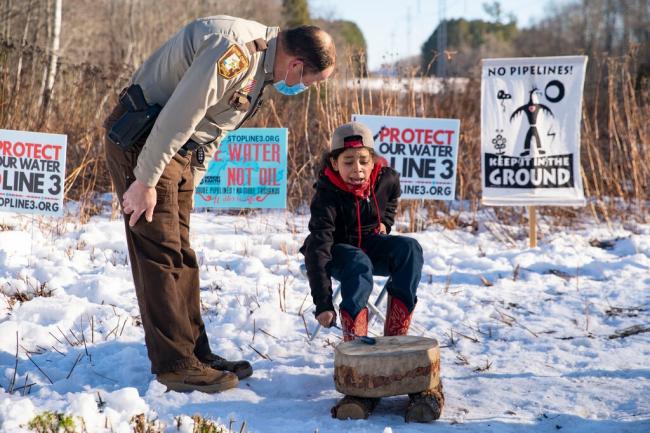Articles Menu

Dec. 28, 2020
PALISADE, Minn. — My daughter and I are walking along the fast-flowing stream of pure darkness that is the young Mississippi River. We are two hours north of Minneapolis, in Palisade, Minn., where people are gathering to oppose the Line 3 pipeline. Patches of snow crunch on pads of russet leaves as we near the zhaabondawaan, a sacred lodge along the river’s banks. It is here that Enbridge is due to horizontally drill a new pipeline crossing beneath the river. We enter the lodge. The peace, the sweetness, the clarity of the water is hard to bear. The brush and trees hardly muffle the roar of earth-moving and tree-felling equipment across the road. The pipeline is almost at the river.
Last month, Minnesota Gov. Tim Walz’s administration signed off on final water permits for Enbridge to complete an expansion of its Line 3 pipeline. After the final section is built in Minnesota, the pipeline will pump oil sands and other forms of crude oil from Hardisty, Alberta, to Superior, Wis., cutting through Indigenous treaty lands along the way. Lawsuits — including one by the White Earth and Red Lake nations and several environmental organizations, and another by the Mille Lacs Nation — are pending. But construction has already started.
This has been a brutal year for Indigenous people, who have suffered nearly double the Covid-19 mortality rate of white Americans. We have lost many of our elders, our language keepers. Covid has also struck an inordinate number of our vibrant young. Nevertheless, tribal people worked hard on the elections. The Native vote became a force that helped carry several key areas of the country and our state. On the heels of those victories, the granting of final permits to construct Enbridge’s Line 3, which will cross Anishinaabe treaty lands, was a breathtaking betrayal. The Land of 10,000 Lakes is already suffering from climate change. Yet Minnesota’s pollution control and public utility agencies refused to take the future of our lakes into account, or to consider treaty rights, in granting permits.
This is not just another pipeline. It is a tar sands climate bomb; if completed, it will facilitate the production of crude oil for decades to come. Tar sands are among the most carbon-intensive fuels on the planet. The state’s environmental impact assessment of the project found the pipeline’s carbon output could be 193 million tons per year. That’s the equivalent of 50 coal-fired power plants or 38 million vehicles on our roads, according to Jim Doyle, a physicist at Macalester College who helped write a report from the climate action organization MN350 about the pipeline. He observed that the pipeline’s greenhouse gas emissions are greater than the yearly output of the entire state. If the pipeline is built, Minnesotans could turn off everything in the state, stop traveling and still not come close to meeting the state’s emission reduction goals. The impact assessment also states that the potential social cost of this pipeline is $287 billion over 30 years.